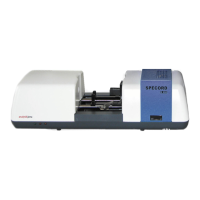Analysis of light-scattering samples
Integrating sphere
SPECORD S600 accessories Edition 09/2014 91
20.2 Using the integrating sphere
In transmittance or diffuse reflectance measurements, the sample is brought
into direct contact with the sphere. In this way, the sample presents a part of the
inner sphere surface thus affecting the efficiency of the sphere. So, for instance,
in transmittance measurements, the radiation is influenced by the residual
reflection in the filled cell thus varying the efficiency of the sphere depending on
the reflective or reflectance properties of the sample. This means that the
efficiency of the sphere depends on the sample properties.
This dependence results in a non-linear functional relation between
transmittance or reflectance and measured signal. For high-precision
measurements, it is therefore advisable to take this non-linear relation into
account by calibrating the system by analogy with quantitative analysis. For the
calibration, certified standards should be used.
The integrating sphere does not require any software settings. However, if you
choose the
Integrating sphere option in WinASPECT, this accessory will
appear in the measurement parameter display
on the screen and on the
20.2.1 Transmittance measurements
The integrating sphere causes homogeneous illumination of the sample from
the opposite hemisphere of the integrating sphere and homogeneous
illumination of the entrance slit of the spectrometer, and thus also of the
detector surface in the spectrometer. A scattering sample produces a radiation
that also radiates into a hemisphere, which however faces the spectrometer.
From this radiation, the portion falling into the angular aperture of the quartz
lens will be detected by the spectrometer. This configuration results in an
improved accuracy of measurement results compared to systems straightly
transilluminating the scattering sample.
Fig. 20-7 illustrates the optical path in transmittance measurement of a
scattering sample in a cell (1). Mirror holder (3) prevents direct light of the
sample from being incident on the sample.

